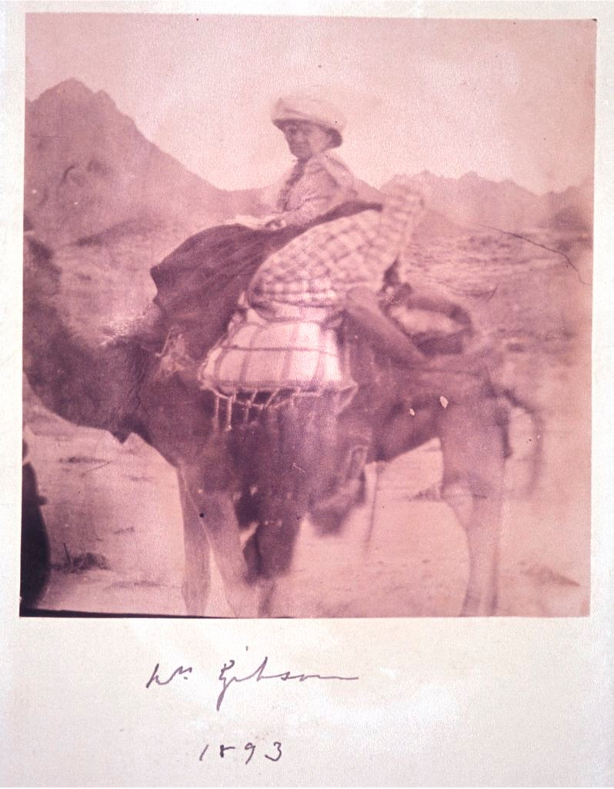Q&A Wednesday: Tales of Cambridge collectors, with Catherine Ansorge

Catherine, what are you working on at the moment?
I’m writing about the Rosetta Stone and a connection it has to Cambridge, dating from the time it was originally shipped from Alexandria to London in 1801. The British Museum’s current exhibition to celebrate the 200th anniversary of the decipherment of hieroglyphs by Jean-Francois Champollion from the text on the Stone, provides a good opportunity to investigate this further.
We’ll look forward to reading about that when your piece is published! You’ve written before about Cambridge’s Egyptologists and their activities in colonial times. How did you come to be interested in these figures?
The archives of some prominent Cambridge Egyptologists are deposited in the Library – people like Thomas Young, Herbert Thompson, F.W. Green and Charles Allberry. I became interested in them when I worked in the faculty library of the Department of Asian and Middle Eastern Studies (then it was called Oriental Studies). I wrote a history of the faculty library and developed an interest in the scholars who were active in the formative years of the faculty and in their book collections.
When I came to work with the Near and Middle Eastern collections here at the University Library, I began to write about the provenance of the Middle Eastern manuscripts here, including a description of major collectors listed chronologically.
I’ve written on the manuscripts of the East India Company chaplain George Lewis, who collected manuscripts in Madras in the early 18th century and then gave a cabinet of them to the University Library in 1727. The cabinet sits today outside the Librarian’s office, but the Arabic and Persian manuscripts it once contained are now kept in the climate-controlled manuscript stacks
I also studied John Lewis Burckhardt, the Swiss explorer who in 1808 came to study Arabic in Cambridge as a young man. He was appointed by the African Association to attempt a crossing of the Sahara to Timbuktu which he never completed, but he did travel widely in Syria and Egypt. When he died in Cairo in 1817 he left his extensive manuscript collection to Cambridge University Library.
I’ve also written on James Rendel Harris, a contemporary of some of the people involved with the Cairo Genizah ‘discovery’, and on Solomon Schechter’s predecessor, Solomon Schiller-Szinessy.
You’re based now in the Genizah Research Unit, and you’ve written about some of the Cambridge figures that were involved in the ‘discovery’ of the collection. Can you tell us about your work on the famous ‘Sisters of Sinai’ – Agnes Lewis and Margaret Gibson?
In 2016, when you and Ben Outhwaite were preparing for the ‘Discarded History’ exhibition, we went together to Westminster College to look at their archives. We saw two travelogues written by Margaret – accounts of her travels from Egypt to the Holy Land in 1896 where the sisters purchase the Genizah fragments that would later spark Solomon Schechter’s interest. I decided to transcribe the travelogues. Agnes’s account had been published as ‘In the Shadow of Sinai’, but Margaret’s writings were never published. I quickly became hooked on her narrative. Margaret writes in much more detail than Agnes, and her observations are more thoughtful too. She wrote on two levels – she recorded their daily activities, but also captured her personal feelings. As they were Presbyterians the act of pilgrimage was very much not a part of their religious tradition, but in Margaret’s writings a spiritual connection is evident to both the journey itself and to earlier pilgrims such as St Sylvia (St Egeria). There are other interesting aspects too. This was their only trip taken specifically to look for and collect manuscripts (on other trips they had only copied and photographed manuscripts), but manuscript collecting is barely mentioned at all in Margaret’s travelogues but possibly that was intentional to focus on her personal experiences.
Do Margaret’s accounts reveal anything about the personal relationships between the sisters?
The relationship between the sisters seems to be very close, but there are other interesting relationships revealed among the very small circle of other Europeans in Jerusalem whom they meet. There are two communities that they interact with – middle class Europeans, who are in professional roles, and the ‘local’ clergy: Armenians, Greek Orthodox, and rabbis. They got on well with the latter group but the religious practices they observed were so different from their own that they are almost acting as anthropologists – appalled and intrigued in equal measure.
I enjoyed reading Margaret’s description of the Holy Fire ceremony at Pentecost in Jerusalem.
I particularly liked the description of their travel to Jerusalem. At this point, in 1986, this was at a sort of ‘tipping point’ for tourism in the Middle East. Thomas Cook’s package holidays had launched in the 1870s and significant numbers of people were starting to arrive in Jerusalem as tourists rather than as pilgrims. But Agnes and Margaret – fabulously wealthy and able to afford any amount of comfort – chose to make their way there through the desert in the traditional way. They came up through the Sinai on camels – camping, with a trusted dragoman, sourcing local food on the way. Initially the way is flat and sandy and the camels do well, but it becomes more difficult as the terrain changes. They end up taking the last part of the journey by train, as the romance of the journey had worn thin. On the outskirts of Jerusalem, they pitched tents, but a downpour left them soaking wet and miserable. Enough was enough, and they decide to check into the best hotel for the rest of their time in the city.
Now you’ve got us feeling sorry for a pair of forlorn and bedraggled millionaires! Thank you for your time, Catherine.
Catherine Ansorge is a researcher in the Genizah Research Unit.

Add new comment